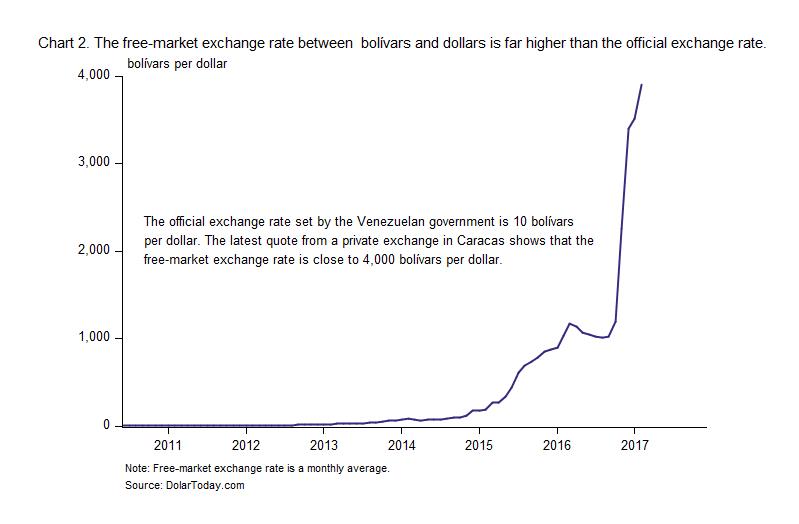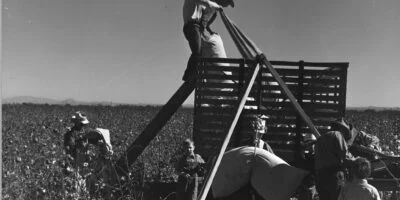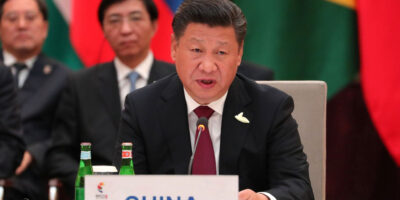Venezuela: Socialism, Hyperinflation, and Economic Collapse
The socialist Bolivarian Revolution in Venezuela led by its late president, Hugo Chávez, appears to have failed. The Venezuelan economy has collapsed and hyperinflation has destroyed the country’s currency. The economy contracted over 10 percent in 2016, and inflation accelerated to 700 percent. President Nicolás Maduro is continuing the disastrous economic policies of the late President Chávez, however.
Chávez was elected in 1999 and implemented a series of redistributive policies aimed at alleviating poverty. The United Socialist Party of Venezuela, the party of Chávez and Maduro, used redistributive policies to reduce inequality at the expense of the overall economy. It is likely that inequality would have been reduced even more had Chávez and Maduro not interfered in the economy. The redistribution policies of Chávez depended completely on revenue from Venezuela’s state-owned oil industry. Private industry was strangled by centrally planned price controls, which caused widespread shortages of basic goods.
Without fundamental reform to restore a stable currency and private incentives, the people of Venezuela will continue to suffer.
Venezuela is at the mercy of world oil prices, despite sitting on top of the world’s largest proven oil reserves. Chávez implemented policies to expand access to housing, education, medical care, and food and paid for them with revenue from oil exports. He could easily subsidize basic goods and services when the price of oil was rising during the 2000s. Oil exports from the state-owned oil company reached 95 percent of the country’s total exports in recent years. This complete dependence on oil left Venezuela vulnerable to changes in its price. In 2014, oil prices began a steep decline, falling from over $100 a barrel in the summer of 2014 to a low of around $33 dollars a barrel in early 2016. Chart 1 shows that the collapse in oil prices reduced Venezuela’s foreign reserves. Fewer foreign reserves mean that the government can no longer subsidize basic goods and services for its people.
The budget shortfall was closed by printing money. Hyperinflation took hold, destroying the savings of individuals and making productive business investment nearly impossible. The government then made things worse by implementing price controls, setting maximum prices that private businesses could charge for a wide range of basic goods, from food to medicine. The government controls set prices well below what otherwise prevailed on the free market. As a result, private business owners have cut back production or shut down as their losses have mounted. The situation in Caracas, the capital, is dire. Grocery-store shelves are empty, and there are widespread shortages of food. The government has expropriated private grocery stores and has used dwindling foreign currency reserves to provide cheap food. The situation is the same in hospitals. They cannot provide adequate medical care because of shortages of gauze, gloves, and drugs.
In addition to domestic price controls, the government fixed the currency exchange rate in an attempt to control inflation. It implemented a tiered system of exchange rates that is different for essential and non-essential goods. The official exchange rate is 10 Venezuelan bolívars per U.S. dollar. The exchange rate ignores the hyperinflation gripping the country. Just as black markets arise in the face of price controls, private markets establish parallel exchange rates in the face of currency controls. DolarToday, a Venezuelan website, tracks market exchanges between bolívars and dollars. Chart 2 shows that the market exchange rate is much higher than the official exchange rate.
The fixed exchange rate is exacerbating economic problems. Many businesses need to import goods at free-market dollar prices. When businesses sell imported goods, they cannot convert the dollar price to bolívars because of government price controls.
The artificially fixed exchange rate is also endangering Venezuela’s last access to international credit markets. To maintain the official exchange rate, the Central Bank of Venezuela must stand ready to buy and sell bolívars in exchange for dollars. The problem is that Venezuela’s dollar reserves are rapidly declining. The latest data from the World Bank shows that reserves have declined to just $15 billion from a peak of $40 billion in 2008.
The loss of dollar reserves resulting from low oil prices and defending a fixed exchange rate has put pressure on debt-service payments. Venezuela borrowed heavily in dollars from international creditors when oil prices were high. After oil prices plummeted and dollar revenues from oil exports fell, the government began to struggle with debt payments. It has paid international creditors at the expense of public subsidies. The government cannot afford to lose credit lines to the state-run oil company; otherwise a complete economic and social collapse is likely.
Socialism and exclusive dependence on the oil industry have led Venezuela down the path of economic collapse, hyperinflation, and social and political unrest. How can the country pull out of its economic nosedive? In the short term, Venezuela is facing a humanitarian crisis that needs to be addressed. Dropping price controls would let businesses import essentials. In the long term, a return to a stable currency is paramount. Plans have been floated to abandon the bolívar for an alternative currency. Some scholars have argued that Venezuela should adopt a dollar standard as Ecuador did in the early 2000s. Socialism needs to be rolled back, and the private sector needs to be allowed to operate. Property rights need to be enforced, and fears of expropriation need to be put to rest. If economic conditions are stabilized, the outflow of financial and human capital will slow. Moves to stabilize the economy will attract foreign capital for desperately needed investment.
Unfortunately, the situation in Venezuela is a replay of other hyperinflation and economic collapses seen throughout history. Prominent examples during the 20th century in Europe include Weimer Germany, post-war Hungary, and Russia following the break-up of the Soviet Union. During the last two decades of the 20th century, Latin America saw hyperinflation in Bolivia, Peru, and Argentina. The common thread between hyperinflation and economic troubles was excessive government debt and redistributive policies. Any government that pursues a policy of printing money, borrowing, and expropriation will harm the economy. When private-market incentives are destroyed, the economy follows suit.










